
YOKOSUKA, Japan – Petty Officer 3rd Class Charleston Bell, a native of Layton, Utah, knew she wanted to see the world and needed to find a way to earn money for school. She chose to do both by enlisting in the U.S. Navy.
Now, three years later and half a world away at Fleet Activities Yokosuka, Bell serves aboard the Arleigh Burke-class guided-missile destroyer USS McCampbell, patrolling one of the world’s busiest maritime regions as part of the leading-edge of U.S. 7th Fleet.
“It's a lot of work, but you get really close to everyone on the ship because you're stuck together,” she said.
Bell, a 2015 graduate of Layton High School, is a fire controlman aboard the Yokosuka, Japan-based ship, one of several in its class forward-deployed to the region.
“I make sure the radar works and I operate it,” Bell said. “It's cool. We're the fleet’s number one air search radar ship. We're the first line of defense and we're going to see a missile first if someone starts shooting at us.”
Bell credits her success in the Navy to some of the lessons she’s learned while serving.
“You need to be a hard worker and you need to have a sense of humor,” she said. “There's too much legitimately serious stuff going on while underway. If you don't have something to joke about, it gets a little heavy.”
U.S. 7th Fleet spans more than 124 million square kilometers, stretching from the International Date Line to the India/Pakistan border; and from the Kuril Islands in the North to the Antarctic in the South. U.S. 7th Fleet's area of operations encompasses 36 maritime countries and 50 percent of the world’s population with between 50-70 U.S. ships and submarines, 140 aircraft, and approximately 20,000 sailors.
“You're out to sea a lot more here,” Bell said. “You go on shorter underways, but you go out more frequently, and you're so close to all the things you hear about on the news. You're part of the first line of defense. You have to have a higher state of readiness on these ships and you have to be fast.”
With more than 50 percent of the world's shipping tonnage and a third of the world's crude oil passing through the region, the United States has historic and enduring interests in this part of the world. The Navy's presence in Yokosuka is part of that long-standing commitment.
"The Navy is forward-deployed to provide security and strengthen relationships in a free and open Indo-Pacific. It's not just the ships and aircraft that have shown up to prevent conflict and promote peace," said Vice Adm. Phil Sawyer, commander, U.S. 7th Fleet. "It is, and will continue to be our people who define the role our Navy plays around the world. People who've made a choice, and have the will and strength of character to make a difference."
Destroyers are warships that provide multi-mission offensive and defensive capabilities. They are 510 feet long and armed with tomahawk land-attack cruise missiles, Standard Missile-3 and newer variants of the SM missile family, advanced gun systems and close-in gun systems. Destroyers are deployed globally and can operate independently or as part of carrier strike groups, surface action groups, or amphibious readiness groups.
Their presence helps the Navy control the sea. Sea control is the precondition for everything else the Navy does. It cannot project power, secure the commons, deter aggression, or assure allies without the ability to control the seas when and where desired.
McCampbell has anti-aircraft capability armed with long range missiles intended for air defense to counter the threat to friendly forces posed by manned aircraft, anti-ship, cruise and tactical ballistic missiles.
Serving in the Navy means Bell is part of a world that is taking on new importance in America’s focus on rebuilding military readiness, strengthening alliances and reforming business practices in support of the National Defense Strategy.
A key element of the Navy the nation needs is tied to the fact that America is a maritime nation, and that the nation’s prosperity is tied to the ability to operate freely on the world’s oceans. More than 70 percent of the Earth’s surface is covered by water; 80 percent of the world’s population lives close to a coast; and 90 percent of all global trade by volume travels by sea.
“Our priorities center on people, capabilities and processes, and will be achieved by our focus on speed, value, results and partnerships,” said Secretary of the Navy Richard V. Spencer. “Readiness, lethality and modernization are the requirements driving these priorities.”
There are many ways for sailors to earn distinction in their command, community, and career. Bell said she’s proud of how much schooling she’s succesfully completed. She said that between her electronics school, her fire controlman school, and a course on becoming a radar technician, the Navy has already spent two years just educating her.
“It got me a lot of college credits,” she said. “There's a lot to learn. I know how to deal with flooding. I didn’t expect to know how to deal with that. I know how to respond to a fire. In the Navy, you just need to know everything.”
As a member of one of the U.S. Navy’s most relied upon assets, Bell and other sailors know they are part of a legacy that will last beyond their lifetimes contributing to the Navy the nation needs.
“You get to serve your country while getting the benefits of free education and a gaining a lot of general skills that you wouldn't normally have,” she said. “And you're out doing something that actually means something in the world, which is cool.”